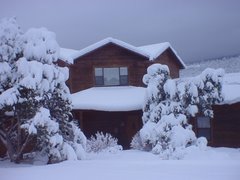Saturday morning I ended up getting a one on one Civil War-themed walking tour of Savannah. Chilly morning and Susie was not terribly interested in the topic, so she asked permission not to go and I graciously granted it (just kidding). Two other people were supposed to take the tour also, but they didn’t show up. Nevertheless, the tour went on: one guide, one tourist.
The guide, Keith, teaches history in a Savannah HS, actually at the Savannah Art Academy. The school system has several magnet/specialty “academies,” one of which is Art. Keith's also pursuing a graduate education – and his wife is about to deliver their first child. Very nice, knowledgeable guy.
Not a lot happened in Savannah pertaining directly to the Civil War, in terms of battles, so a lot of the walk and Keith’s presentation pertained to the social and political climate at the time. (Disclaimer: What follows is written mostly from recollection and is not guaranteed to be 100% accurate.)
W.r.t. the Civil War, though, here’s the story: The Union Army occupied Fort Pulaski at the mouth of the Savannah River in 1862, part of a blockade of Southern ports that gradually strangled the South. I asked if either (a.) the Confederate Army tried to re-take the fort or (b.) the Union army moved against Savannah. No, in either case – both sides’ positions were too strong.
Then, in late 1864, Sherman’s army approached the city, finishing their march across Georgia, fresh from destroying Atlanta. Sherman, with 65,000 men, threatened the city: Surrender or else. The Confederates, with 10,000 men, opted not to resist, but successfully abandoned the city. Savannah's mayor said to Sherman: It’s yours.

I asked whether it was surprising that Sherman spared Savannah or that the Confederates decided not to fight to the last man. Not really. Sherman knew it would have been a costly victory – he would have lost many troops. Both sides knew the war was nearly over. No reason to keep fighting. So, Sherman’s troops occupied the city peacefully. He telegraphed to Lincoln (quote from Wikipedia):
"I beg to present you as a Christmas gift the City of Savannah, with one hundred and fifty guns and plenty of ammunition, also about twenty-five thousand bales of cotton."
... and a partridge in a pear tree. That Sherman, as you can tell from the above picture, was a real kidder.
Sherman was known for his 'scorched-earth' policy, but the only Savannah destruction that was mentioned is that the troops camped in the cemetery damaged or knocked down tombstones and opened tombs to get out of the weather. Several displaced tombstones are displayed on one wall of the Colonial Cemetery.
Some earlier history, roughly as Keith told it. In the early 1800s the South was flourishing, mostly by selling cotton to England and France. When Andrew Jackson was elected, he didn’t like the situation. The economy in the North was suffering. Jackson’s philosophy was that the states should put first priority on doing business at home – he wanted a self-sufficient country that didn’t need Europe as a customer. The South said, Hey, that’s not how a capitalist economy works. You sell where you get the best price. Jackson said, I’ll fix you and he imposed tariffs that made European trade unprofitable.
Jackson’s VP was James Calhoun, of SC. He strongly disagreed with Jackson and in 1831 resigned in protest – the first VP to do so, the only other being Spiro Agnew, for other reasons. Calhoun agitated for states’ rights and stirred up talk of secession. There was even a joint threat by SC and NY to secede – they had a side deal that would help both states. Jackson said: I’ll regard secession as a declaration of war and I’ll smash you. The South said, Hey, take it easy. We get the picture. Never mind. Add slavery to the picture, though, and the situation worsened and it was not long until secession and war.
Here's a picture of Keith, playing his penny whistle, standing in front of John Wesley's statue in Reynolds Square. This is where the tour started and ended.
There's a link between Sherman and Wesley, via New Mexico. Thomas Harwood was a chaplain in Sherman's army who, after the war, went to NM as a Methodist missionary. At one point Harwood was threatened by supporters of NM land baron, Lucien Maxwell. He said, "I have ridden with Sherman. Shall I cower like a dog before these lowlifes who threaten me?" He did carry a gun and nobody messed with him.
Keith told me about various houses along our routes, including some claimed to have ghostly inhabitants. Ghosts are big in Savannah. Keith said one home "had a lot of heat" in it. Hadn't heard that phrase -- means lots of ghost-energy. Keith said he had had some ghost experiences -- notably the unexplained odor of cigar smoke in the basement of the school building he works in. This is one of his research interests. Churches are another.
Anyway, another good tour. Not only the history, but Keith took me through some scenic squares I hadn't seen before.
Saturday afternoon we went to the Seafood Festival in the riverfront area of Savannah. I had some “wild Georgia Shrimp.” These are taken from the Atlantic Ocean, as opposed to being pond-grown as is most commercial shrimp. We walked the shops on River Street and Susie found a Georgia charm in a jewelry store across from Paula Deen's.
Sunday we're going to attend church at the Wesley Monumental church, then head for Florida.
Cheers,
Rob and Susie









No comments:
Post a Comment